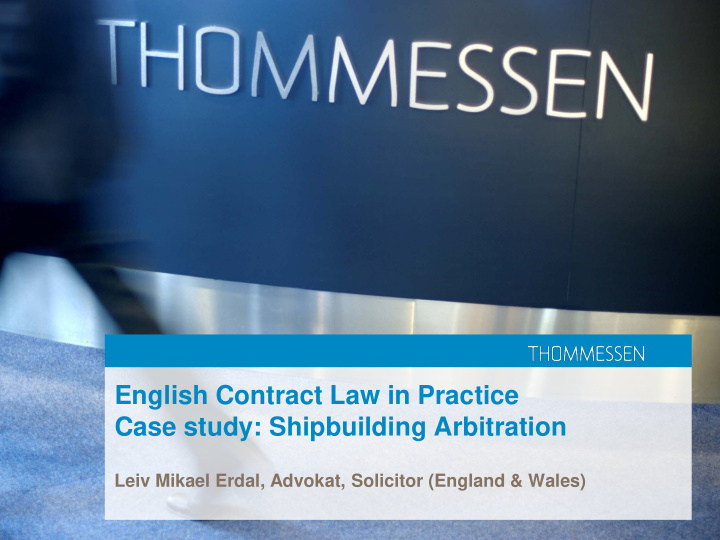



English Contract Law in Practice Case study: Shipbuilding Arbitration Leiv Mikael Erdal, Advokat, Solicitor (England & Wales)
Introduction • About Thommessen – One of Norway’s leading law firms – Specialist Shipping & Offshore department • English law in a Norwegian practice – Especially relevant in shipping, offshore, oil and gas and financing transactions – English law is a neutral and familiar choice of law in contracts, also regarded by many international businesses as a commercial and predictable alternative with highly qualified judges and arbitrators – ”London arbitration” for dispute resolution is an established concept – The London market is key to brokerage, insurance, financing etc. – Many of the biggest global law firms have their main offices there • My view: knowledge of English law concepts – even if you cannot formally advise in it – is essential in practice in a department like ours 2
Today’s topic: a shipbuilding arbitration case study • The issues: 1. Interpretation of a performance standard – breach? 2. Obtaining a remedy: quantifying an (uncertain) loss • A typical arbitration under English procedure: 1. Appointment of arbitrators 2. Written submissions 3. Evidence/witness statements and disclosure 4. Expert evidence 5. Oral hearing 6. Arbitral award / costs award • Questions before we begin? 3
Case study Issue I: Interpretation Basic principles of contractual interpretation to keep in mind • The point of departure: words are to be given their ordinary and natural meaning, but: – ” A word is not a crystal, transparent and unchanged, it is the skin of a living thought and may vary greatly in colour and content according to the circumstances and the time in which it is used.” (Holmes J., in Towne v Eisner (1918) 245 U.S. 416) • Interpretation of commercial contracts should have regard to the custom in the trade and ”business common sense”: – ” If a detailed semantic and syntactical analysis of words in a commercial contract is going to lead to a conclusion that flouts business commonsense, it must yield to business commonsense” ( Lord Diplock in The Antaios [1984] AC 191) – ” where a term of contract is open to more than one interpretation, it is generally appropriate to adopt the interpretation which is most consistent with business common sense” (Lord Clarke in Rainy Sky SA and ors v Kookmin Bank [2011] UKSC 50) 4
Case study Issue II – Quantum Basic legal principles • Remedies (the basics) – action for an agreed sum or liquidated damages – equitable remedies: specific performance, injunction etc. – restitution – damages • Damages (the basics) – the claimant has to show (i) a loss resulting from the breach that is not too remote, and (ii) the amount of loss suffered – in the arbitration, only (ii) was really an issue, i.e. ” the measure of damage s” • The measure of damages (aka. ”quantum”) – The point of departure: loss or bargain / "loss of expectations” : the injured party claims to be put ” so far as money can do it…in the same situation…as if the contract had been performed. ” Robinson v Harman (1848) – In Norwegian: oppfyllelsesinteressen / positiv kontraktsinteresse 5
Case study Issue II – Quantum Basic legal principles (cont.) • The measure of damages continued… – damages are compensatory – but for what? – difference of value vs. cost of cure • Peevyhouse v Garland Coal Co (1962) (US) • presumed (i): that where a seller delivers goods which are not of contract quality, damages are usually assesed on a difference in value basis • presumed (ii): where a defendant is in breach of an obligation to do building work, he must put the defects right or complete the work – the cost of cure • however: depending on the circumstances, both presumptions can be rebutted • Sometimes, a different method altogether needs to be applied, cf. ”loss of amenity” in Ruxley v Forsyth (1995) • Difference in value calculations can be particularly difficult – Where there is a market: difference between market value and the contract value – But what if there is no market? • Damages assessed on a reliance or restitutionary basis 6
THANK YOU FOR YOUR ATTENTION
Recommend
More recommend